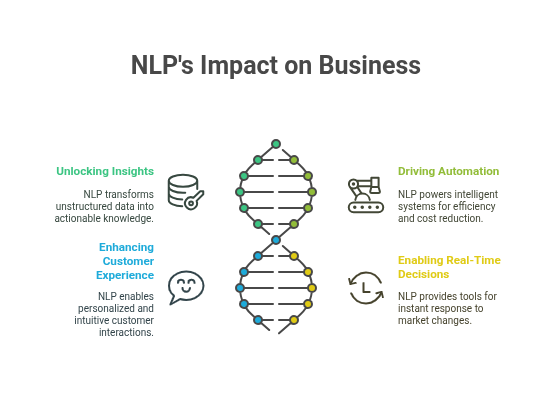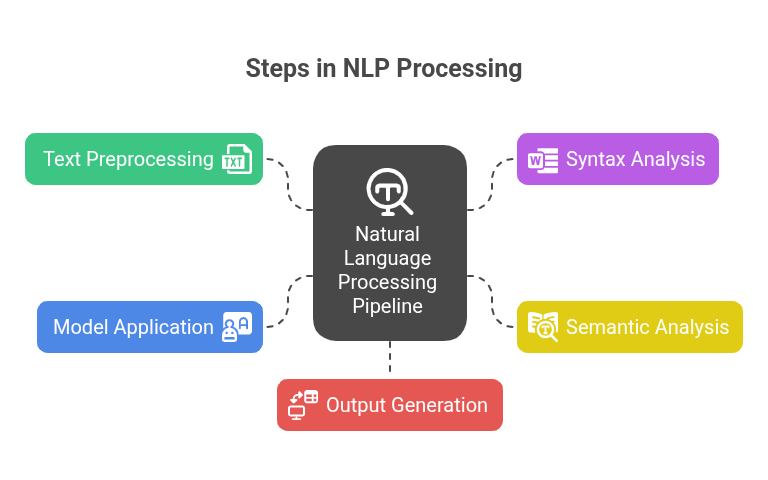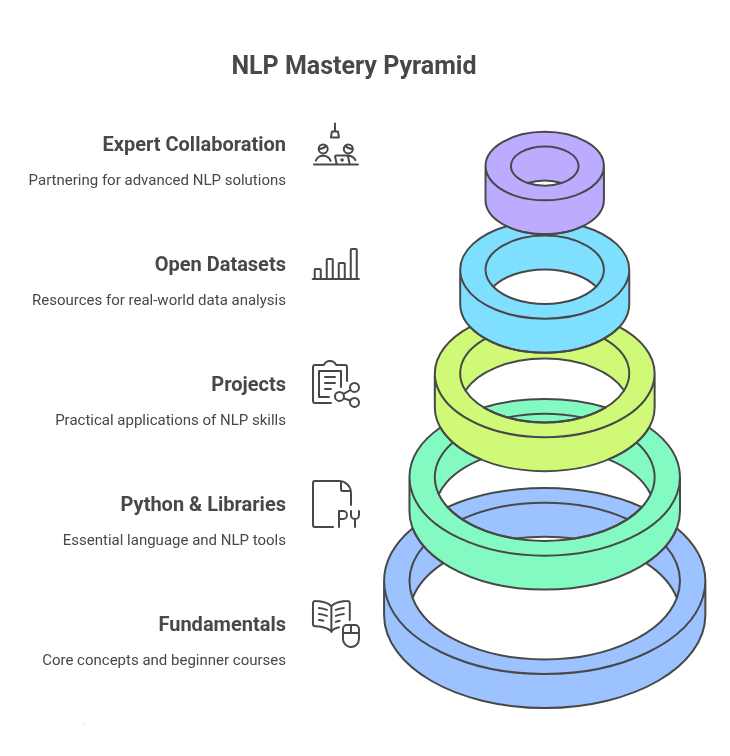Natural Language Processing
Summary
This guide from Ksolves provides an in-depth exploration of Natural Language Processing (NLP), offering a comprehensive understanding of its fundamentals, techniques, business applications, and future trends. Whether you’re a CTO, product manager, or consultant, this guide will demystify NLP and show how it can transform business communication and decision-making through AI-powered language understanding.
Introduction
Human communication is messy, diverse, and incredibly rich. With the explosion of digital content, enterprises are now generating massive amounts of unstructured textual data through emails, social media, reviews, documents, and more. But how can a machine understand and use this data? The answer is facilitated by Natural Language Processing (NLP).
NLP enables machines to comprehend human language. It’s the force behind virtual assistants like Siri and Alexa, predictive text in Gmail, and real-time translation tools. For businesses, NLP enables chatbots, sentiment analysis, and intelligent automation. In short, NLP bridges the gap between human communication and digital systems.
What is Natural Language Processing (NLP)?
NLP is a subset of artificial intelligence (AI) and computational linguistics that focuses on enabling computers to understand, interpret, and generate human language. Unlike structured data, such as numbers, natural language is complex and often ambiguous. NLP uses linguistic rules, statistical models, and deep learning to bridge this gap.
Key capabilities of NLP include:
- Understanding grammar and sentence structure (syntax)
- Extracting meaning and sentiment (semantics)
- Translating languages
- Generating coherent responses or summaries
Also Read:
- History and Evolution of Natural Language Processing
- NLP vs. Traditional Data Analysis: What’s the Difference?
- NLP vs. NLU vs. NLG: What’s the Difference?
Why Does NLP Matter?
Here are some compelling reasons why NLP is critical today:
- Unlocks Insights from Unstructured Data
NLP transforms unstructured text like emails, documents, and social media into structured data, enabling organizations to extract valuable insights, make informed decisions, and leverage otherwise inaccessible information.
- Drives Automation
By interpreting human language, NLP enables automation of repetitive tasks like answering queries or processing documents, boosting operational efficiency, and reducing the need for constant human intervention.
- Enhances Customer Experience
NLP enables natural and personalized interactions through virtual assistants, smart replies, and tailored recommendations, leading to more engaging, responsive, and satisfying customer experiences across digital channels.
- Enables Real-Time Decision-Making
With real-time sentiment analysis and trend tracking, NLP enables businesses to swiftly respond to shifts in public opinion, customer feedback, and market dynamics, thereby gaining a competitive edge in fast-moving environments.
Also Read:
- NLP in Customer Service
- Real-World Scenarios Where NLP Saves Time and Money
- How NLP Integrates with Machine Learning and AI
- How NLP Helps in Uncovering Insights from Unstructured Data
What is NLP Used For?
NLP applications are widespread and evolving. Here’s how it’s being used today:
- Customer Support: NLP is used in chatbots, email sorting, and ticket categorization to provide faster responses, reduce workload for support teams, and enhance user satisfaction through automated assistance.
- Healthcare: It helps process clinical notes, transcribe doctor-patient conversations, and analyze patient feedback, enabling more accurate diagnosis, improved documentation, and better healthcare delivery.
- Finance: NLP aids in detecting fraud, ensuring regulatory compliance, and organizing financial documents by interpreting complex language, enhancing security and efficiency in financial operations.
- E-commerce: From suggesting products to analyzing reviews and powering intelligent search, NLP personalizes the shopping experience and helps businesses better understand consumer behavior.
- Marketing: NLP enables brands to analyze sentiment, measure campaign impact, and gain deep audience insights, guiding more targeted, data-driven marketing strategies and improving overall ROI.
- Legal & Research: NLP streamlines contract review, document summarization, and information extraction, saving time and enhancing accuracy in legal and academic work.
NLP in Business
Natural Language Processing is transforming the way businesses operate by unlocking insights from vast amounts of unstructured text data—emails, customer reviews, chat logs, and more.
Enterprises are using NLP to automate customer support, analyze sentiment, streamline internal workflows, and personalize user experiences. From intelligent chatbots to real-time market feedback analysis, NLP empowers decision-makers with actionable intelligence. Whether in e-commerce, healthcare, finance, or legal sectors, NLP enhances productivity, reduces operational costs, and improves customer engagement. By embedding NLP into digital strategies, businesses gain a competitive edge in understanding both their customers and the market more deeply.
Also Read:
How Does Natural Language Processing Work?
NLP systems follow a series of steps to process and understand language:
- Text Preprocessing
- Tokenization: Splitting text into words/sentences
- Stop Words Removal: Eliminating common, less meaningful words (e.g., “the”, “is”)
- Stemming and Lemmatization: Reducing words to their root form
- Syntax Analysis
- Part-of-Speech Tagging: Identifying nouns, verbs, adjectives, etc.
- Parsing: Understanding grammatical structure
- Semantic Analysis
- Named Entity Recognition (NER): Identifying entities like names, dates, locations
- Coreference Resolution: Linking pronouns to the nouns they refer to
- Model Application
- Applying ML/DL models for tasks such as classification, translation, or generation
- Output Generation
- Producing structured results like sentiment scores, summaries, or chatbot responses
Also Read:
Semantic Analysis v/s Syntactic Analysis in Natural Language Processing
Top NLP Techniques
| Technique | Use Case | Business Benefit |
| Named Entity Recognition | Extracting people, dates, and locations from text | Structured insights from unstructured data |
| Sentiment Analysis | Analyzing customer reviews and social media | Brand perception and feedback monitoring |
| Text Classification | Email sorting, content tagging | Workflow automation |
| Machine Translation | Cross-language document translation | Global reach and communication |
| Topic Modeling | Discovering themes in customer feedback | Product improvement, marketing targeting |
| Summarization | Condensing large reports | Faster decision-making |
| Question Answering | Chatbots and customer support systems | Automated user assistance |
1. Named Entity Recognition (NER)
Identifies specific entities like names, places, dates, and organizations in text, helping structure unstructured data for applications like search engines and customer feedback analysis.
2. Sentiment Analysis
Analyzes text to determine emotional tone—positive, negative, or neutral—commonly used in social media monitoring, product reviews, and customer service feedback.
3. Text Classification
Assigns predefined labels to text based on content, such as sorting emails into spam or not spam, or categorizing news articles by topic or genre.
4. Language Modeling
Predicts the next word in a sentence or evaluates sentence coherence, forming the backbone of autocomplete, speech recognition, and text generation systems.
5. Machine Translation
Automatically translates text from one language to another, enabling cross-lingual communication and content accessibility across different languages and cultures.
6. Topic Modeling
Uncovers hidden thematic structures within large text collections using algorithms like LDA, helping with document clustering, trend analysis, and information retrieval.
7. Summarization
Generates brief, coherent summaries from lengthy texts either by extracting key sentences (extractive) or rephrasing main ideas (abstractive), improving information consumption.
8. Question Answering
Builds systems that understand user queries and provide accurate answers using context from documents or databases, simulating human-like responses in chatbots and virtual assistants.
Also Read:
- All About Named Entity Recognition (NER)
- How Sentiment Analysis Is Transforming Brand Monitoring
Important NLP Models
1. BERT
A transformer-based model by Google that reads text bidirectionally, enabling deeper understanding of context and meaning in tasks like question answering and sentence classification.
2. GPT Series
OpenAI’s generative models (e.g., GPT-3, GPT-4) produce coherent, human-like text. They’re used in chatbots, content creation, coding assistance, and many natural language tasks.
3. RoBERTa
Facebook’s optimized BERT variant, trained longer with more data and dynamic masking, achieves improved accuracy in language understanding tasks like classification and sentiment analysis.
4. T5
Google’s T5 (Text-to-Text Transfer Transformer) reformulates every NLP task as text input-to-text output, offering a unified framework for tasks like translation, summarization, and classification.
5. XLNet
Enhances BERT by using permutation-based language modeling, capturing better dependency information, and improving performance on a variety of NLP benchmarks.
6. Open-Source Toolkits
- SpaCy: Lightweight and fast
- NLTK: Educational and widely used for experimentation
- Transformers by Hugging Face: Pretrained models for all major tasks
While these advanced models, such as GPT, BERT, and T5, deliver exceptional performance, they also come with significant computational demands. Organizations must carefully consider strategies for cost-efficient deployment, including selecting the appropriate model size, optimizing prompt design, leveraging caching mechanisms, and choosing suitable inference types (real-time, batch, or serverless).
Challenges and the Future of NLP
Current Challenges
- Ambiguity: Words have multiple meanings depending on context
- Data Bias: Models can inherit societal or dataset bias
- Multilingual Processing: Supporting languages with fewer digital resources
- Understanding Nuance: Sarcasm, humor, and tone are hard for machines to grasp
The Future
- Low-resource NLP: Building tools for less-represented languages
- Real-time NLP: Speeding up processing for real-time insights
- Explainable AI: Making NLP decisions more transparent and interpretable
- Ethical AI: Fairness, bias correction, and privacy-aware NLP development
Also Read:
- What Makes GPT-4 a Game Changer for Conversational AI?
- How T5 and XLNet Are Redefining NLP Tasks
- Open Source NLP Tools: When to Use SpaCy, NLTK, or Hugging Face?
How to Get Started in NLP
1. Learn Fundamentals
- Understand core concepts: syntax, semantics, ML basics
- Take beginner-friendly courses (Coursera, Udemy, edX)
2. Master Python and Libraries
- Python is the go-to language
- Explore SpaCy, NLTK, and Hugging Face
3. Work on Projects
- Sentiment analysis of tweets
- Text classification for emails or reviews
- Chatbot development using open-source models
4. Use Open Datasets
- Kaggle, UCI NLP datasets, or Google Dataset Search
5. Partner with Experts
- Collaborate with NLP consulting services providers like Ksolves for enterprise-grade solutions. Our experts help identify the right models, ensure smooth integration with your current infrastructure, and align solutions with your business goals. Whether you’re exploring custom chatbot development, sentiment analysis, or document automation, a consulting partner can accelerate your NLP journey and deliver measurable results.
NLP Integration in Your Tech Stack
Integrating Natural Language Processing into your existing tech stack doesn’t have to be a disruptive overhaul—it can be a strategic enhancement that fits seamlessly with your current systems and workflows. Whether you’re building a customer-facing chatbot or automating document processing, the key is aligning NLP capabilities with your business goals and technical infrastructure.
1. Identify Use Cases Aligned with Business Goal
Start by pinpointing NLP applications that directly address business pain points. Examples include:
- Automated customer support (via chatbots)
- Sentiment analysis of user reviews or social media
- Document classification for compliance or HR workflows
- Email triage and routing
2. Select the Right Tools and Frameworks
Your choice of tools depends on your team’s technical expertise, budget, and use case complexity.
- Beginner-friendly APIs: Google Cloud NLP, AWS Comprehend, Microsoft Azure Text Analytics
- Customizable libraries: SpaCy, NLTK, Hugging Face Transformers
- Enterprise-grade platforms: OpenAI, Cohere, or custom Ksolves NLP solutions
3. Ensure Scalable Infrastructure
For production-ready NLP applications:
- Use containerization (Docker) and orchestration (Kubernetes) to scale.
- Leverage GPU/TPU instances for deep learning workloads.
- Adopt cloud services or on-premise deployments depending on data sensitivity.
4. Enable Seamless Integration with APIs
Most modern NLP tools offer RESTful APIs, making it easy to:
- Connect with CRM, ERP, or customer support platforms
- Integrate into mobile or web applications
- Automate backend workflows with Python, Node.js, or Java-based services
5. Monitor, Evaluate, and Optimize
Post-deployment, monitor model performance and user feedback continuously.
- Use A/B testing, feedback loops, and error analysis to refine outcomes.
- Implement logging and alerting for data drift or system anomalies.
Pro Tip: Partnering with a consulting service like Ksolves helps reduce time-to-market by ensuring best practices in NLP integration, model selection, deployment, and scaling.
Ksolves NLP Services: Enterprise-Ready Solutions for Real-World Impact
At Ksolves, we bring the power of Natural Language Processing from theory to implementation, offering tailored NLP solutions that solve business challenges across industries. Whether you’re building a smart assistant, analyzing sentiment at scale, or automating document workflows, our NLP services are designed to maximize ROI and minimize complexity.
Why Choose Ksolves for NLP?
- End-to-End Consulting
From strategy to deployment, we guide you through every step of your NLP journey—helping you define goals, identify use cases, and select the right tools and models. - Custom Model Development
We develop and fine-tune models based on leading architectures like BERT, GPT-4, RoBERTa, and T5, optimized for your specific industry and dataset. - Seamless Integration
Our solutions are built to integrate effortlessly with your existing systems—CRM, ERP, cloud platforms, or mobile apps—via secure and scalable APIs. - Scalable Infrastructure Support
Whether you need real-time inference or batch processing, we help you deploy NLP solutions using Docker, Kubernetes, or your preferred cloud infrastructure. - Cross-Functional Expertise
We cater to a diverse set of users—from SaaS product managers to digital transformation consultants—ensuring that both technical and non-technical stakeholders gain value.
Solutions We Deliver
- AI Chatbots & Virtual Assistants
Enable intelligent, human-like interactions that improve customer satisfaction and reduce support load. - Sentiment & Intent Analysis
Monitor brand perception, analyze feedback, and guide marketing strategies with real-time sentiment insights. - Document Automation
Automate legal reviews, HR document processing, and compliance workflows using entity recognition and summarization. - Language Translation & Multilingual NLP
Break language barriers with machine translation and support for multilingual data pipelines. - Domain-Specific Text Classification
Build robust classifiers for spam detection, lead scoring, or content moderation tailored to your business needs.
Conclusion
Natural Language Processing (NLP) is no longer just a research domain but an important aspect reshaping how businesses interact with data, customers, and decisions. From automating support to unlocking insights from text, NLP empowers organizations to act faster, smarter, and more efficiently. Whether you’re a product manager evaluating AI features, a consultant guiding digital transformation, or a business analyst seeking customer intelligence, understanding NLP is critical. With evolving models like BERT, GPT-4, and accessible toolkits such as Hugging Face, the path to implementation is clearer than ever. At Ksolves, we help bridge the gap between potential and execution, bringing enterprise-ready NLP solutions to life. For more information and guidance on NLP solutions, contact our experts at sales@Ksolves.com.






